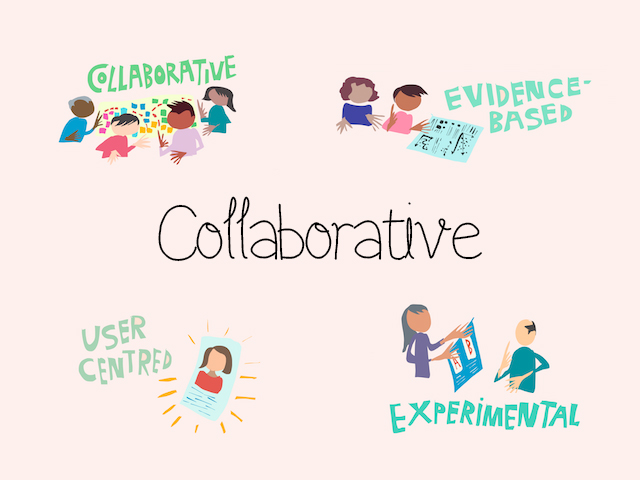Shift to a Collaborative Approach
A2JBC encourages a culture shift in the justice system towards user-centred, collaborative, and experimental projects and initiatives, which are based on evidence. We call this the A2JBC Approach.
It means shifting away from working in silos, to thinking of how we can collaborate to better serve the users of the justice system.
The A2JBC Approach envisions collaboration on many levels. It could mean coordination among organizations that provide the same services or that target the same sub-populations. It could include the government and the courts, despite the acknowledgment of their mutual independence. It could involve lawyers, mediators and members of other professions. It could be across sectors at the government ministerial or the community service level.
Collaboration heightens the collective capacity to learn from experience and develop effective strategies to improve access to justice.
Being Collaborative
Most reports that have been written about access to justice have advocated for collaboration. Yet, with some important exceptions, the pattern of the justice system remains siloed. There is a reason for this. Collaboration takes time, and it can be messy.
Being collaborative does not mean doing everything together. Sometimes organizations work best on their own, within their own mandate. Collaboration can be at the highest level, for example, around the A2J Triple Aim, or at the level of common strategies with decentralized activities, or at the level of individual projects that could be more impactful if done in conjunction with others. The question needs to be asked: when is collaboration likely to get better results, and then the hard work needs to be done to make it work.
A2JBC is a Collaborative
A2JBC itself would not exist except for the conviction that the problem of access to justice cannot be solved by one person or organization.
By convening leaders of different justice sector organizations, A2JBC is creating a space for collaborative relationships and ideas to develop. The collaboratives that A2JBC has supported have all involved many organizations working together. Lessons have been learned about the challenges of collaboration, especially between larger and smaller organizations. A true collaboration involves the sharing of decision-making and that does not come easily to organizations that are used to making their own decisions. A2JBC will continue to encourage and support collaborative action and and explore how to make it work better.
The developing Family Justice Collaborative
A2JBC is contemplating how it could lead a cross-sectoral Family Justice Collaborative that will transform the family justice system - based on what the evidence tells about brain science, the Adverse Childhood Experiences and resilience – so that it promotes family well-being in everything it does.
Collaborative Stories
Welcome from the Chief Justice
Welcome to the Access to Justice BC website. It is my sincere pleasure to provide updates on Access to Justice BC’s activities and progress, continuing the work of my predecessor, founding chair Robert Bauman, KC. I look forward to reaching people across the province who are concerned about the accessibility of the civil and family justice system in BC. I…
Read MoreLaunch of the Transform the Family Justice System Collaborative
This blog post is based on the Chief Justice’s speech delivered at the June 7, 2022 launch event On June 7, 2022—nearly three years after the signing of the Access to Justice Triple Aim—I was pleased to take part in the launch of the Transform the Family Justice System (TFJS) Collaborative. The TFJS Collaborative arises directly from A2JBC’s commitment in…
Read MoreNew centres deliver a culturally-safe approach to justice for Indigenous clients
In March 2020, the BC First Nations Justice Council (BCFNJC), BC First Nations communities and the Province of British Columbia, signed the first-ever BC First Nations Justice Strategy (Strategy). As part of this ground-breaking and transformative initiative, an integral component of the Strategy is the creation of a number of Indigenous Justice Centres (IJCs) across the province. A year later…
Read MoreBCCA Collaborates to Streamline Appeal Process
The BCCA digitizes the process for bringing an appeal.
Read MoreThe Triple Aim Signing Ceremony
The Triple Aim, borrowed from the health care sector, is a single goal with three elements: improved experience for the users of the justice system, improved population access to justice and improved costs.
Read MoreBC Provincial Court and “Clicklaw” collaborate on one-page guides
The BC Provincial Court and the website Clicklaw are collaborating to provide one-page, up-to-date summaries of the most useful online resources.
Read More
A2J Stories
Supporting Organizations

